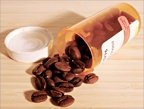Sleep homeostasis is the process by which the body establishes a steady state of physiological balance and readiness.
From the moment of morning wakefulness, the homeostatic drive for sleep accumulates until it reaches its maximum late in the evening, establishing enough pressure to sustain about eight continuous hours of slumber. Although the exact neurological mechanisms aren't fully understood, sleep most likely involves the nucleoside adenosine. Adenosine binds to receptors in the basal forebrain that control the cells that are essential for wakefulness, and turns them off, triggering sleep. Levels of adenosine rise continuously during the day as cells break down ATP (adenosine triphosphate) to generate energy. While awake and active, the body burns ATP and thus, adenosine levels rise, creating the pressure for sleep. During sleep, there is a marked decrease in cellular activity.
 Caffeine molecules are similar in structure to adenosine and bind to the same receptors that signal the pressure for sleep, thus blocking the homeostatic sleep drive. Masking tiredness is a signature feature of caffeine. Caffeine also prevents adenosine from dilating the brain's blood vessels (theoretically, to increase oxygen efficiency during sleep). That's why caffeine is found in many over-the-counter headache pain medications, such as Anacin. If a headache is vascular in nature, caffeine helps relieve the pain by narrowing the blood vessels.
Caffeine molecules are similar in structure to adenosine and bind to the same receptors that signal the pressure for sleep, thus blocking the homeostatic sleep drive. Masking tiredness is a signature feature of caffeine. Caffeine also prevents adenosine from dilating the brain's blood vessels (theoretically, to increase oxygen efficiency during sleep). That's why caffeine is found in many over-the-counter headache pain medications, such as Anacin. If a headache is vascular in nature, caffeine helps relieve the pain by narrowing the blood vessels.
All of this activity caused by the caffeine also triggers the body to release epinephrine (adrenaline), another anti-sleep chemical. Adrenaline, among other things, increases the heart rate and blood pressure, dilates the pupils, increases blood sugar levels, and increases the blood supply to the large muscle groups in the body.
| Average Caffeine Levels for Popular Energy Drinks |
| Energy Drink | Caffeine (mg) |

|
| Spike Shooter (8.4 oz.) | 300 |
| Cocaine (8.4 oz.) | 280 |
| Monster Energy (16 oz.) | 160 |
| Full Throttle (16 oz.) | 145 |
| SoBe No Fear (8 oz.) | 85 |
| Red Bull (8.3 oz) | 80 |
| Amp (8.4 oz.) | 75 |
Restrict Your Caffeine Intake
Moderate amounts of caffeine ingested in the morning are sufficiently metabolized by bedtime - they won't have a major impact on sleep. However, caffeine has a half-life of four to seven hours, which means substantial amounts of caffeine consumed later in the day will linger in the body well past the evening. For example, a well-known chain of coffee shops has a large-sized coffee product that contains more than 500 mg of caffeine (roughly five times that of an average cup of drip coffee). If you were to drink that as a "pick-me-up" at 3 p.m. to "get through the day," half of the caffeine could still be in the body at bedtime. In other words, a 10 p.m. bedtime could be challenged by the caffeine equivalent of two full cups of coffee! One might be tired enough to fall asleep, but the caffeine tampers with the quality and depth of the sleep, damaging sleep's valuable restorative powers.
Simply restricting caffeine intake after the noon hour could have dramatic effects on the ability to fall asleep at night and the ensuing quality of one's sleep. It also may negate or reduce the need for sleep aids. Nature wins, and so does the sleeper!
Talk to your doctor about any sleep-quality issues or sleep difficulties you may be experiencing. Your doctor can help pinpoint areas of concern and develop lifestyle habits that can keep you rested and rejuvenated for all life has in store for you.
| Average Caffeine Levels for Popular Over-the-Counter Drugs |
| Medication | Caffeine (mg) |

|
NoDoz, maximum strength (1),
or Vivarin (1) | 200 |
| NoDoz, regular strength (1) | 100 |
| Excedrin, extra strength (2) | 130 |
| Anacin, maximum strength (2) | 65 |
| | |
For more information on caffeine content,
visit the Center for Science in the Public
Interest (www.cspinet.org). |

